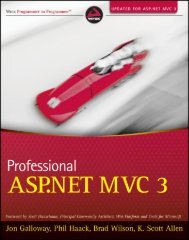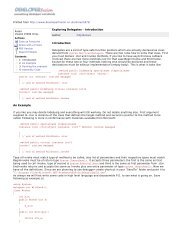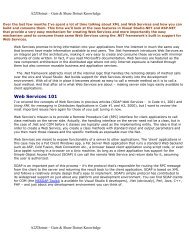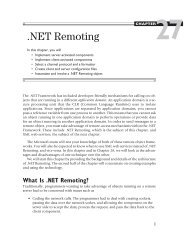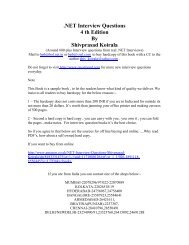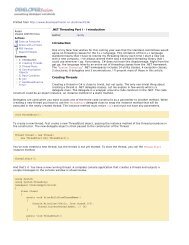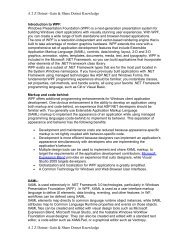DOT NET Interview Questions - DotNetSpider
DOT NET Interview Questions - DotNetSpider
DOT NET Interview Questions - DotNetSpider
You also want an ePaper? Increase the reach of your titles
YUMPU automatically turns print PDFs into web optimized ePapers that Google loves.
(A)What are fact tables and dimension tables in OLAP ?<br />
Twist :- can you explain the star schema for OLAP ?<br />
The dimensions and measures are physically represented by a star schema.Dimension<br />
tables revolve around fact table. A fact table contains a column for each measure as well<br />
as a column for each dimension. Each dimension column has a foreign-key relationship<br />
to the related dimension table, and the dimension columns taken together are the key to<br />
the fact table.<br />
(A)What is DTS?<br />
DTS is used to pull data from various sources into the star schema.<br />
(A)What is fillfactor ?<br />
Twist :- When does plage split occurs ?<br />
The 'fill factor' option specifies how full SQL Server will make each index page. When<br />
there is no free space to insert new row on the index page, SQL Server will create new<br />
index page and transfer some rows from the previous page to the new one. This operation<br />
is called page splits. You can reduce the number of page splits by setting the appropriate<br />
fill factor option to reserve free space on each index page. The fill factor is a value from<br />
1 through 100 that specifies the percentage of the index page to be left empty. The<br />
default value for fill factor is 0. It is treated similarly to a fill factor value of 100, the<br />
difference in that SQL Server leaves some space within the upper level of the index tree<br />
for FILLFACTOR = 0. The fill factor percentage is used only at the time the index is<br />
created. If the table contains read-only data (or data that very rarely changed), you can<br />
set the 'fill factor' option to 100. When the table's data modified very often, you can<br />
decrease the fill factor to 70% or whatever you think is best.<br />
(A)What is RAID and how does it work ?<br />
Redundant Array of Independent Disks (RAID) is a term used to describe the technique<br />
of improving data availability through the use of arrays of disks and various data-striping<br />
methodologies. Disk arrays are groups of disk drives that work together to achieve higher<br />
data-transfer and I/O rates than those provided by single large drives. An array is a set of<br />
multiple disk drives plus a specialized controller (an array controller) that keeps track of<br />
how data is distributed across the drives. Data for a particular file is written in segments<br />
to the different drives in the array rather than being written to a single drive.<br />
199



